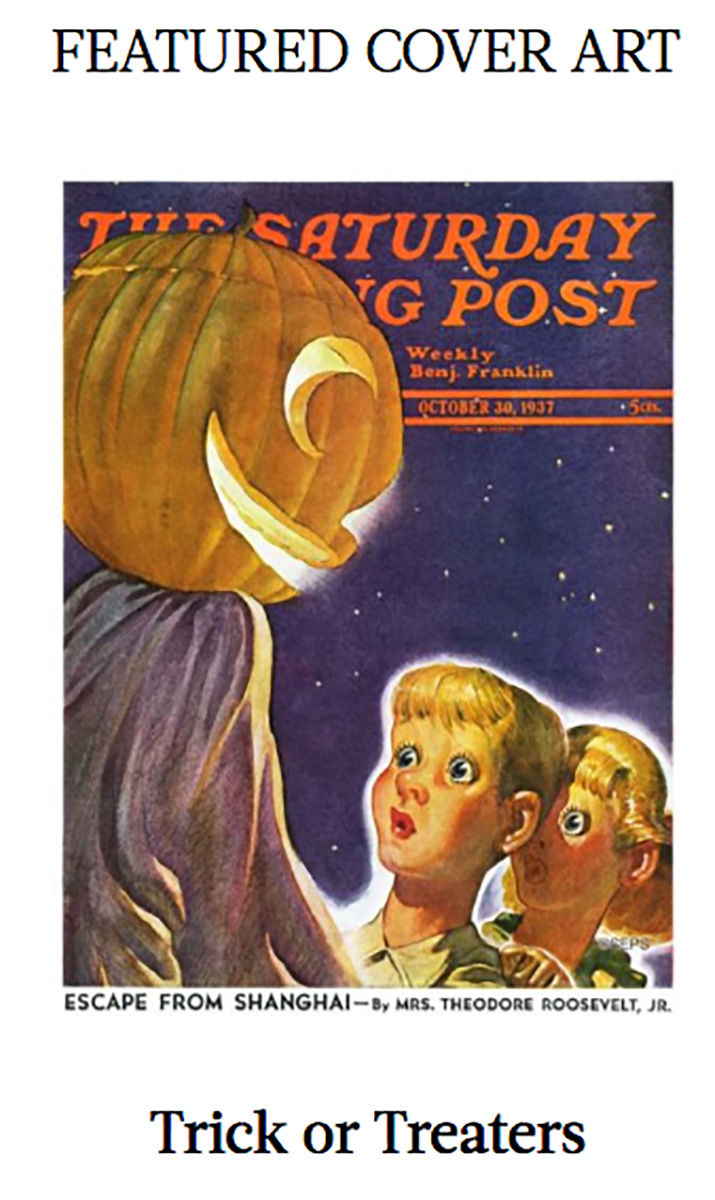Artist spent his formative years along Hannibal’s St. Mary’s Ave.
- Mary Lou Montgomery

- Apr 12, 2019
- 5 min read

Link to Velie’s art:
The Saturday Evening Post has a web site dedicated to the artists who created their covers:
https://www.saturdayeveningpost.com/artists/robert-b-velie/

Robert B. Velie, who is credited with the Oct. 30, 1937 cover design for the Saturday Evening Post, spent his boyhood at 3000 St. Mary’s Avenue, on the northeast corner of Hill and St. Mary’s in Hannibal, Mo. MARY LOU MONTGOMERY
MARY LOU MONTGOMERY
Like so many others who grew up along Hannibal’s northwest quadrant, Robert Briggs Velie likely wore out his shoe leather along St. Mary’s Avenue. From 1907 until around 1917, (when he was about 14 years old) he lived in a double-story house on the northeast corner of St. Mary’s and Bird, along with his parents, Maurice and Minnie Velie, and two brothers. As a middle child (born in 1904), he helped earn his keep as a delivery boy for Harry Houck’s Dairy, which was located to the north and west of town, and as a newspaper carrier along the graveled avenue.
While his childhood no doubt instilled many core values born of experience in this river town, Robert Velie would end up a half continent away from his Midwestern roots, with adventures to his credit that were unimaginable back when he delivered milk, butter and newspapers, either on foot or by horsepower, back in Hannibal, Mo., pre-1918.
Throughout the years of Robert Velie’s youth, St. Mary’s Avenue was an unpaved graveled road used by county residents to access downtown Hannibal. (* It wasn’t until 1922 that the announcement would come that the avenue was to be paved.)
Maybe Robert Velie followed that same path downtown and to the river. He obtained a love for sailing somewhere, if not in his hometown.
Move to Chicago
When Robert was still a teen, Maurice Velie moved his family to Chicago, where he would continue his trade as a contractor and house builder.
But instead of following the carpentry trade like his father and grandfather before him, Robert displayed an interest in art, and attended the Art Institute in Chicago. He went on to be named the art director of National Store Display for Sears Roebuck Company, and designed many of that company’s displays for the 1934 World’s Fair.
Following that success, he moved to New York City where he worked as a commercial artist.
In 1937, according to an article in the Oct. 27, 1937 Marion County Standard, he was chosen to design the Halloween cover for the Saturday Evening Post. Other publications also sought his work, including Liberty, The Digest and This Week magazines.
His Saturday Evening Post cover was on the stands Oct. 30, 1937.
Adventures
His destiny of creating a cover for a national magazine might never had been fulfilled if it hadn’t been for some Devine intervention in June 1926.
Velie, then aged 22, who had acquired a keen interest in sailing and a 30-foot sailing yacht, set out for a pleasure cruise on Lake Michigan with three of his pals, Ray Johnson, Charles Snapp and Glenn Holland, all from Chicago.
What they weren’t expecting when they sailed that day was, as described by the Associated Press, “a perilous adventure in one of the most violent storms to rage over the lake in many years.”
The 60-mile-per-hour gale tossed and tumbled the boat and its helpless occupants.
Three days later, the boat, “its main mast splintered and fragments of its sails hanging in rags,” washed up to shore near the port at Grand Haven, Mich. Miraculously, the four men were safe.
When found, “They were fatigued, drenched, and so numbed by cold they were almost unable to speak.
“How far they had been blown by the 60 mph gale, where they had drifted, how many times the storm had changed their direction or what port they were approaching after their thirty foot craft finally weathered the blast, they did not know,” the Omaha World Herald reported.
Tempting fate
In 1934, when Robert Velie was about 30, he decided to join a friend on a sailing adventure from New York to the West Indies. The boat was a 30-foot auxiliary sailing yacht owned by Leslie Ragan, a fellow artist. Also along on the adventure was Ragan’s wife.
The two artists took along their art supplies and planned to spend some time sketching in the Virgin Islands before their return trip.
The trio took off from New York, and all went well until they reached Cape Romain, off the coast of South Carolina. The sloop struck a floating object, and it started taking on water faster than the men could bail it out.
“Our auxiliary engine was not powerful enough to keep us before the wind and we were drifting to sea,” Velie told the Charles News and Courier, which published the story in its Nov. 13, 1934 edition.
They set out a flare and caught the attention of the crew of the Clyde Mallory liner, which was able to pull up beside the small vessel and lower a Jacob’s ladder to rescue the sailors.
“They abandoned the yacht to the mercy of the waves,” the newspaper reported.
Houck’s dairy
Harry Houck, for whom Robert Velie work as a youth, began in the dairy business in 1901, when he purchased a milk and butter business from Mr. James, a rural Hannibal dairyman. His early business included the milking of 30 cows on his farm in the Indian Mound area. In March 1901, Houck hired Luther Douglas, previously employed on the Hatch farm, to manage his dairy department. Houck took an active role in the local dairy business, establishing a showplace and gaining for himself a reputation as a leader in the local dairy association.
Houck’s daughter married Girard Secker, and the two were in business together until the elder dairyman’s death in 1944.
Velie’s death
Maurice Velie – Robert’s father - was a son of Hannibal, born in 1869 to Alexander and Fanny (Buchanan) Velie, and reared on Valley Street on Hannibal’s South Side. He learned the carpentry trade from his father, a Civil War veteran who had served with Company K, 10th Missouri Infantry.
Maurice R. Velie died May 27, 1951. His wife, Minnie, died four years later.
Robert Velie married Eloise Sexton in 1940, and they settled in Tenafly, N.J., where they raised their daughter, Gailyn.
Robert died in 1960, and his wife died in 1993.
Notes
1922: “St. Mary’s Avenue Hannibal, is to be paved, which will be good news to many people in Marion county outside of that city. “ May 17, 1922 Palmyra Spectator
1915: “The Marion county Land and Loan Co., which suspended business a year or more ago, disposed of their last piece of real estate at public auction last Friday It was a two story pressed brick residence on St. Mary’s Avenue in Hannibal, and was bid by James Sterling of Miller township for $3,225.00 Mr. Sterling, it is understood, will move to Hannibal and his son will manage his farm.” Sept. 29. 1915 Palmyra Spectator. (James Sterling was a juror at the September 1894 trial during which Dorcas Hampton challenged her father’s will. “The Notorious Madam Shaw.” Sterling’s house was next door to the north of the Velie house.)
Mary Lou Montgomery retired as editor of the Hannibal Courier-Post in 2014. She researches and writes narrative-style stories about the people who served as building blocks for this region’s foundation. Her collective works can be found at www.maryloumontgomery.com




















Comments